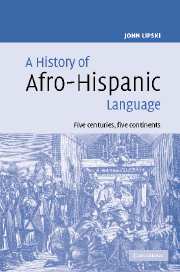Book contents
- Frontmatter
- Contents
- Acknowledgments
- Note on the Appendix
- Introduction
- 1 Africans in the Iberian peninsula, the slave trade, and overview of Afro-Iberian linguistic contacts
- 2 Early Afro-Portuguese texts
- 3 Early Afro-Hispanic texts
- 4 Africans in colonial Spanish America
- 5 Afro-Hispanic texts from Latin America: sixteenth to twentieth centuries
- 6 Survey of major African language families
- 7 Phonetics/phonology of Afro-Hispanic language
- 8 Grammatical features of Afro-Hispanic language
- 9 The Spanish-Creole debate
- References
- Index
7 - Phonetics/phonology of Afro-Hispanic language
Published online by Cambridge University Press: 24 February 2010
- Frontmatter
- Contents
- Acknowledgments
- Note on the Appendix
- Introduction
- 1 Africans in the Iberian peninsula, the slave trade, and overview of Afro-Iberian linguistic contacts
- 2 Early Afro-Portuguese texts
- 3 Early Afro-Hispanic texts
- 4 Africans in colonial Spanish America
- 5 Afro-Hispanic texts from Latin America: sixteenth to twentieth centuries
- 6 Survey of major African language families
- 7 Phonetics/phonology of Afro-Hispanic language
- 8 Grammatical features of Afro-Hispanic language
- 9 The Spanish-Creole debate
- References
- Index
Summary
Introduction
Spanish came into contact with a variety of West and Central African languages during a time period stretching across nearly four centuries, under widely varying demographic conditions and sociohistorical circumstances. Many dialects of Spanish were involved, ranging from sixteenth-century Andalusian Spanish, in which the phonological traits that today make this dialect so distinctive were just emerging, to distinctive Caribbean, Andean, and Pacific South American dialects of the eighteenth and nineteenth centuries, already far evolved from the Peninsular antecedents. Thus the result of Africans' pronunciation of Spanish varied as the Spanish dialects themselves evolved: for example, the product of an Angolan Bantu language and early sixteenth-century Peninsular Spanish were qualitatively different from the product of the same Bantu language and nineteenth-century Cuban or coastal Peruvian Spanish. Even more diverse was the panoply of African languages that ran headlong into Spanish and Portuguese, first in Europe and coastal Africa, then in the Americas. All African language families were implicated; through sheer force of numbers, Bantu languages (stretching from the Gulf of Guinea through southern Africa and around to much of eastern Africa) eventually came to represent the largest single cross-section of African languages, with Kwa languages in second place, and the remainder divided among Kru, Mende, Atlantic, and other smaller groups. Each dyadic contact between a particular African language and a specific spatial/temporal variety of Spanish gave rise to a unique pattern of phonological adaptation, in principle making the totality of Afro-Hispanic phonology as vast as the union of African languages and Spanish dialects over several hundred years.
- Type
- Chapter
- Information
- A History of Afro-Hispanic LanguageFive Centuries, Five Continents, pp. 204 - 244Publisher: Cambridge University PressPrint publication year: 2005



